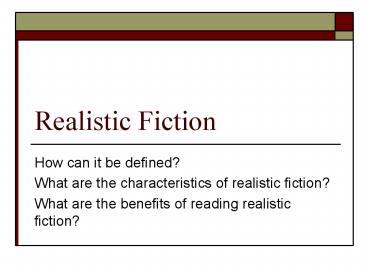Realistic Fiction - PowerPoint PPT Presentation
1 / 16
Title:
Realistic Fiction
Description:
What are the benefits of reading realistic fiction? ... Romance and Sexuality. Rites of Passage. Adventures and Survival. Which ones have you read? ... – PowerPoint PPT presentation
Number of Views:378
Avg rating:3.0/5.0
Title: Realistic Fiction
1
Realistic Fiction
- How can it be defined?
- What are the characteristics of realistic
fiction? - What are the benefits of reading realistic
fiction?
2
From the mid-1850s till the late 1920s, an
estimated 100,000 homeless children were sent by
train from New York City to small towns and farms
in the Midwest. Charles Loring Brace of the
Childrens Aid Society hope to place them with
caring families. Some of the children did well.
Some did not. Some exchanged one kind of misery
for another. Some found security and even love.
This is the story of fourteen orphan children,
going West, dreaming of a better life. The
Orphan Train itself is real the route it takes
and the place names are fictional. The town of
Somewhere exists only on the map of the authors
imagination.
3
Create an open-mind portrait for one character in
this book.
4
Train to Somewhere
5
Realistic Fiction
- Stories that could happen to people and animals
- Protagonists are fictional but their actions and
reactions are like those of real people and
animals - Sometimes actions and events are exaggerated but
are definitely possible
6
Realistic Fiction
- Factual realism
- Situational realism
- Emotional realism
- Social realism
- Contemporary realism
7
Realistic Fiction
- Factual realism-descriptions of real people,
places, and events (which must be recorded
accurately, i.e. names actual people, places, and
events) - Situational realism-the situation is possible but
also quite likely (the characters ages, events,
and social actions) - Emotional realism-believable feelings and
relationships of characters (rites of passage and
growing up stories) - Social realism-honest portrayal of society and
its conditions of the moment - Contemporary realism-stories that take place in
the present time and portray attitudes and mores
of the present culture (may focus on social
issues such as alcoholism, racism, poverty, and
homelessness)
8
Realistic Fiction
- Set in the present or recent past
- Dialogue, references to popular culture, customs,
and dress are characteristic of contemporary
realistic fiction - Older outdated stories are referred to as
realistic fiction, though all are not classics
9
Selecting Realistic Fiction
- Well developed characters who change as a result
of significant life events - Well-structured plot that holds the readers
interest - Time and place suitable to the storyline
- A worthy theme, the moral must not be the main
theme - Must be believable and possible
- Topics of social and contemporary
importance-these may at times be controversial - Humorous events and silly circumstances
- A balanced selection of the types of realistic
fiction is important
10
Realistic Fiction-History
- Early realistic fiction was didactic and was
intended to teach manners and morals - Robinson Crusoe was published in 1719 for adults
but enjoyed too by children - In 1744 John Newberrys books were for children
and were intended to entertain and to educate - Other early realistic fiction that changed the
themes of realistic fiction Swiss Family
Robinson, Kidnapped, Little Women, Adventures of
Huckleberry Finn, Anne of Green Gables, The
Silver Skates, Heidi, and Black Beauty
11
Types of Realistic Fiction
- Families
- Peers
- Special Challenges
- Cultural Diversity
- Animals
- Sports
- Mysteries
- Moral Choices
- Romance and Sexuality
- Rites of Passage
- Adventures and Survival
- Which ones have you read?
12
The Structure of Narrative Text
13
Response Options for Narrative Text
- Small group discussions
- Questioning
- Synthesizing
- Graphic organizers to scaffold vocabulary and
comprehension development - Modeling
- Metacognition
14
Critical Literacy-Reading Against the Grain
15
Conclusion
- Top Five
- Summary
16
Book Talk Groups

